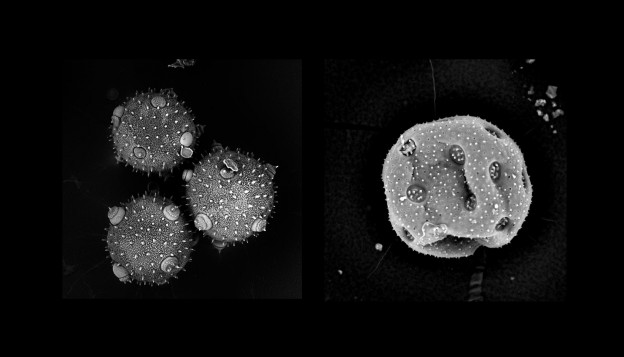‘Agency’ is the capacity of an actor to act in a given environment. Since Darwin, it is clear that flowers and bees engage in an evolutionary race. The honeybee is a complex insect with numerous sensorial features which are matching perfectly with the demands of sensual plants.
The black-and-white photographs reveal the elaborate design of some dissected parts of flowers and honeybees. All samples are collected in the Urban Bee Lab, my apiary and rooftop garden laboratory in the centre of Brussels. I made the images with a Scanning Electron Microscope (SEM) in the laboratory of chemical engineering at the Vrije Universiteit Brussels (VUB), with the kind help of Dr. Alexander Lutz.

Scanning Electron Micrographs, large size prints on Archival Rag paper 305gr
Detailed Description per Micrograph:
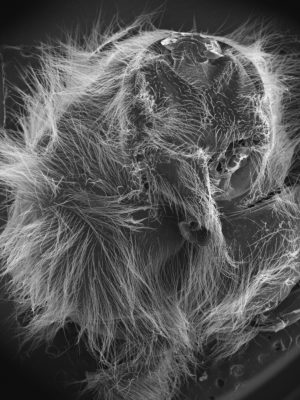

Caput (150x magnified) (160cm x 2015cm)
Bee head top and side.

Glossa (x 150 magnified) 160cm x 215cm
Glossa is the Greek word for ‘tongue’. The glossa is similar to a long segmented cylinder covered with hairs. When the bees are foraging, the tongue is extended and immersed into the nectar. The hairs on the glossa erect to collect the liquid and the nectar is sucked into throat of the bee. Besides being a feeding instrument, the bee-tongue serves also for licking the queens’ pheromones which regulate the life in the hive. So it is also a kind of communication instrument.
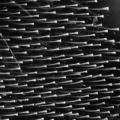
Scopae (x 480 magnified) 80cm x 80cm
Bees collect pollen, floral oils and other chemicals from plants. The scopae is a particularly dense mass of elongated hairs on the hind leg of a honeybee. Together with the pollen-basket the scopae form a pollen-carrying apparatus that is used to transport pollen from the flower to the nest.
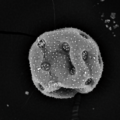
Mentha, Single Pollen Grain (x 3400 magnified) 80cm x 80cm
An isolated pollen grain of Mentha spicata, Lamiaceae. 78,9 micron and 3400x magnified.

Black Debris (x 250 magnified) 160cm x 215cm
The black debris is a small pollution particle that I collected on the bottom of the beehive. The fur of the honeybee is electrostatically charged and thus the hairs attract, besides pollen, also plenty of pollution particles that the bees bring back to the beehive.

Proboscis (x 150 magnified) 160cm x 215cm
A proboscis is an elongated appendage from the head of a honeybee. The term proboscis refers to the tubular mouthparts used for feeding and sucking. Relative to the size of the average honeybee, the proboscis is long, a result of evolution ensuring the bee can reach the center of a flower to collect nectar.
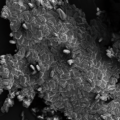
Pollen Cluster (x 250 magnified) 160cm x 215cm
A cluster of pollen from a non-identified flower. The apertures and the flat aspect of the pollen in the cluster tell us that the pollen are probably some days old. Pollen are an important source of nutrition in the life and development of the young honeybee.
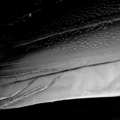
Bee Wing (x 270 magnified) 80cm x 80cm
The wings of the honeybee have a very specific design and their fight mechanism is an example of delicate technology. A bee carrying a load of nectar and pollen would require a wing too large to allow it to enter many of the flowers it collects from. Therefore the honeybee is equipped with a double wing. When flying, the two parts hook together with some kind of Velcro-system. And they fold neatly into one wing when reaching the flower to collect the nectar.
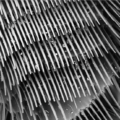
Curbicula (x 265 magnified) 80cm x 80cm
The honey bee has a pollen basket or curbicula. This is a polished cavity surrounded by a comb of stiff hairs. The bee moistens the legs, head and body with her extruded tongue and brushes the pollen that stick everywhere to the back of the body. With the pollen comb the pollen are pressed and compacted before being transferred to the pollen basket on the outside surface of the hind legs.
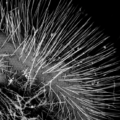
Bee Eye (x 295 magnified) 80cm x 80c
m
The bee’s eyes differ greatly from human eyes. They consist of a pair of compound eyes made up of numerous six-sided facets. They also have three simple eyes (occuli). Despite this, their vision is sharp for a distance of only 1 meter. A compound eye cannot register the fine detail of our own eyes, but it is particularly good at detecting and following motion. Bees navigate by ultraviolet light which penetrates clouds and they use the sun as a reference point to communicate to other bees the angle of fight to be followed to arrive at newly discovered foraging fields.

Exoskeleton (x100 magnified) 160cm x 215cm
A piece of the skeleton of the honeybee, collected on the bottom of the beehive.
